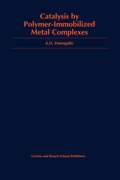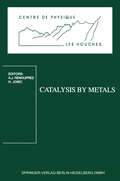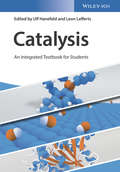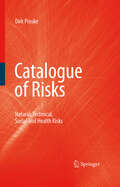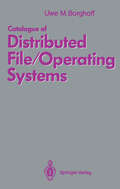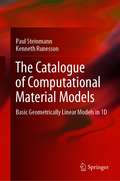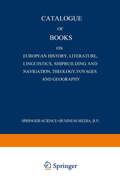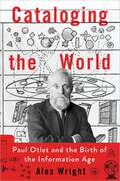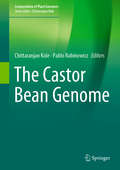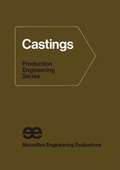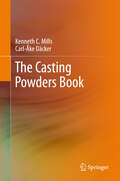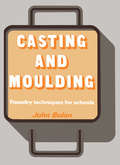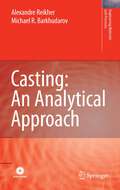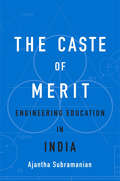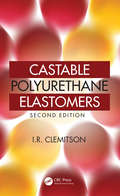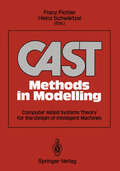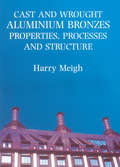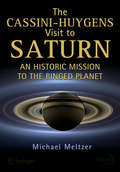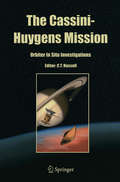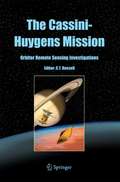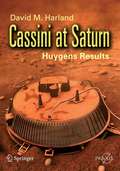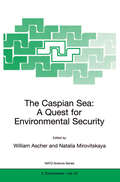- Table View
- List View
Catalysis by Polymer-Immobilized Metal Complexes
by Anatoly D. PomogailoDeals with a new and promising field developed during the last two decades on the boundary between homogeneous and heterogeneous catalysis. This book presents general information on catalysis for a wide range of organic reactions, e.g., hydrogenation and oxidation reactions, and polymerization transformations. Special attention is paid to electro- and photochemical stimulation of catalytic processes in the presence of immobilized metal complexes. Other topics covered are the quantitative data on the comparison of catalyses by mobile and immobilized metal complexes; main factors affecting the activity of these catalytic systems and methods of optimizing their control; and specific problems of catalysis by fixed complexes (e.g., ligand exchange and electron transfer in metal polymer systems, macromolecular effects and polyfunctional catalysis).
Catalysis by Metals: Les Houches School, March 19–29, 1996 (Centre de Physique des Houches #6)
by Albert Jean Renouprez Herve Jobic JobicCatalytic reactions on metals are still nowadays involved in more than half of the chemical industrial processes. The winter school held at "I 'Ecole de in March 1996, 13 years after the first one, accounts Physique des Houches" for an evolution of the field in several directions. First, the emulation between theoretical chemistry and solid state physics has emerged on heuristic concepts, leading not only to explanations of the observed phenomena but, for the first time, to predictions of the reactivity of catalytic systems and of the reaction pathways. The second domain which during these years has become of primary importance is the abatement of the pollution. It concerns not only the conversion of polluting effluents but more and more major modifications of the processes to avoid the production of undesired products. Two striking examples are the necessary catalytic conversion of the 100 000 cubic meter of hydrogen that would be produced in a major incident of a nuclear power plant and the replacement of the CFC. The valorization of agricultural supplies can already be considered as one of the major achievement of catalysis. Indeed, the carbon of biosustainable raw materials represents more than 2 orders of magnitude the amount extracted from fossil fuels each year. Moreover, the molecules are already highly functionalised in contrast with hydrocarbons which require costly steps to be converted to the same products. They are now of current use in the elaboration of cosmetics, vitamins, polymers, etc.
Catalysis: An Integrated Textbook for Students
by Ulf Hanefeld Leon LeffertsWritten by an excellent, highly experienced and motivated team of lecturers, this textbook is based on one of the most successful courses in catalysis and as such is tried-and-tested by generations of graduate and PhD students, i.e. the Catalysis-An-Integrated-Approach (CAIA) course organized by NIOK, the Dutch Catalysis research school. It covers all essential aspects of this important topic, including homogeneous, heterogeneous and biocatalysis, but also kinetics, catalyst characterization and preparation, reactor design and engineering. The perfect source of information for graduate and PhD students in chemistry and chemical engineering, as well as for scientists wanting to refresh their knowledge
Catalysis: An Integrated Textbook for Students
by Ulf Hanefeld Leon LeffertsWritten by an excellent, highly experienced and motivated team of lecturers, this textbook is based on one of the most successful courses in catalysis and as such is tried-and-tested by generations of graduate and PhD students, i.e. the Catalysis-An-Integrated-Approach (CAIA) course organized by NIOK, the Dutch Catalysis research school. It covers all essential aspects of this important topic, including homogeneous, heterogeneous and biocatalysis, but also kinetics, catalyst characterization and preparation, reactor design and engineering. The perfect source of information for graduate and PhD students in chemistry and chemical engineering, as well as for scientists wanting to refresh their knowledge
Catalogue of Risks: Natural, Technical, Social and Health Risks
by Dirk ProskeSince the German edition of this book, the topic of risk has experienced even greater attention, not only in the world of science but also in other fields, such as economics and politics. Therefore, many new publications have evolved. To keep with the idea of an encyclopedia for the topic of risk, this book has been completely reworked. Not only are many updated examples included in chapter “Risks and disasters” but also new chapters have been introduced, such as the chapter “Indetermination and risk”. This new chapter was developed since the question “Is it possible for risks to be completely eliminated, and if not why?” has become a major point of c- cern. Therefore, especially in this chapter, the focus of the book has - tended from a simple mathematical or engineering point of view to include much broader concepts. Here, not only aspects of system theory have to be considered, but also some general philosophical questions start to inf- ence the considerations of the topic of risk. The main goal of this edition, however, is not only the extension and revision of the book, but also the translation into the English language to allow more readers access to the ideas of the book. The author deeply hopes that the success the book made in the German edition continues and that readers experience a major gain from reading the book.
Catalogue of Distributed File/Operating Systems
by Uwe M. BorghoffIn general, distributed systems can be classified into Distributed File Systems (DFS) and Distributed Operating Systems (DOS). The survey which follows distinguishes be tween DFS approaches in Chapters 2-3, and DOS approaches in Chapters 4-5. Within DFS and DOS, I further distinguish "traditional" and object-oriented approaches. A traditional approach is one where processes are the active components in the systems and where the name space is hierarchically organized. In a centralized environment, UNIX would be a good example of a traditional approach. On the other hand, an object-oriented approach deals with objects in which all information is encapsulated. Some systems of importance do not fit into the DFS/DOS classification. I call these systems "closely related" and put them into Chapter 6. Chapter 7 contains a table of comparison. This table gives a lucid overview summarizing the information provided and allowing for quick access. The last chapter is added for the sake of completeness. It contains very brief descriptions of other related systems. These systems are of minor interest or do not provide transparency at all. Sometimes I had to assign a system to this chapter simply for lack of adequate information about it.
The Catalogue of Computational Material Models: Basic Geometrically Linear Models in 1D
by Paul Steinmann Kenneth RunessonThis book gives a comprehensive account of the formulation and computational treatment of basic geometrically linear models in 1D. To set the stage, it assembles some preliminaries regarding necessary modelling, computational and mathematical tools. Thereafter, the remaining parts are concerned with the actual catalogue of computational material models. To this end, after starting out with elasticity as a reference, further 15 different basic variants of material models (5 x each of {visco-elasticity, plasticity, visco-plasticity}, respectively) are systematically explored. The presentation for each of these basic material models is a stand-alone account and follows in each case the same structure. On the one hand, this allows, in the true sense of a catalogue, to consult each of the basic material models separately without the need to refer to other basic material models. On the other hand, even though this somewhat repetitious concept may seem tedious, it allows to compare the formulation and resulting algorithmic setting of the various basic material models and thereby to uncover, in detail, similarities and differences. In particular, the response of each basic material model is analysed for the identical histories (Zig-Zag, Sine, Ramp) of prescribed strain and stress so as to clearly showcase and to contrast to each other the characteristics of the various modelling options.
Catalogue of Books on European History, Literature, Linguistics, Shipbuilding and Navigation, Theology, Voyages and Geography
by Martinus NijhoffCataloging the World: Paul Otlet and the Birth of the Information Age
by Alex WrightThe dream of capturing and organizing knowledge is as old as history. From the archives of ancient Sumeria and the Library of Alexandria to the Library of Congress and Wikipedia, humanity has wrestled with the problem of harnessing its intellectual output. The timeless quest for wisdom has been as much about information storage and retrieval as creative genius. In Cataloging the World, Alex Wright introduces us to a figure who stands out in the long line of thinkers and idealists who devoted themselves to the task. Beginning in the late nineteenth century, Paul Otlet, a librarian by training, worked at expanding the potential of the catalog card, the world's first information chip. From there followed universal libraries and museums, connecting his native Belgium to the world by means of a vast intellectual enterprise that attempted to organize and code everything ever published. Forty years before the first personal computer and fifty years before the first browser, Otlet envisioned a network of "electric telescopes" that would allow people everywhere to search through books, newspapers, photographs, and recordings, all linked together in what he termed, in 1934, a réseau mondial--essentially, a worldwide web. Otlet's life achievement was the construction of the Mundaneum--a mechanical collective brain that would house and disseminate everything ever committed to paper. Filled with analog machines such as telegraphs and sorters, the Mundaneum--what some have called a "Steampunk version of hypertext"--was the embodiment of Otlet's ambitions. It was also short-lived. By the time the Nazis, who were pilfering libraries across Europe to collect information they thought useful, carted away Otlet's collection in 1940, the dream had ended. Broken, Otlet died in 1944. Wright's engaging intellectual history gives Otlet his due, restoring him to his proper place in the long continuum of visionaries and pioneers who have struggled to classify knowledge, from H.G. Wells and Melvil Dewey to Vannevar Bush, Ted Nelson, Tim Berners-Lee, and Steve Jobs. Wright shows that in the years since Otlet's death the world has witnessed the emergence of a global network that has proved him right about the possibilities--and the perils--of networked information, and his legacy persists in our digital world today, captured for all time.
Cataloging the World: Paul Otlet and the Birth of the Information Age
by Alex WrightThe dream of capturing and organizing knowledge is as old as history. From the archives of ancient Sumeria and the Library of Alexandria to the Library of Congress and Wikipedia, humanity has wrestled with the problem of harnessing its intellectual output. The timeless quest for wisdom has been as much about information storage and retrieval as creative genius. In Cataloging the World, Alex Wright introduces us to a figure who stands out in the long line of thinkers and idealists who devoted themselves to the task. Beginning in the late nineteenth century, Paul Otlet, a librarian by training, worked at expanding the potential of the catalog card, the world's first information chip. From there followed universal libraries and museums, connecting his native Belgium to the world by means of a vast intellectual enterprise that attempted to organize and code everything ever published. Forty years before the first personal computer and fifty years before the first browser, Otlet envisioned a network of "electric telescopes" that would allow people everywhere to search through books, newspapers, photographs, and recordings, all linked together in what he termed, in 1934, a réseau mondial--essentially, a worldwide web. Otlet's life achievement was the construction of the Mundaneum--a mechanical collective brain that would house and disseminate everything ever committed to paper. Filled with analog machines such as telegraphs and sorters, the Mundaneum--what some have called a "Steampunk version of hypertext"--was the embodiment of Otlet's ambitions. It was also short-lived. By the time the Nazis, who were pilfering libraries across Europe to collect information they thought useful, carted away Otlet's collection in 1940, the dream had ended. Broken, Otlet died in 1944. Wright's engaging intellectual history gives Otlet his due, restoring him to his proper place in the long continuum of visionaries and pioneers who have struggled to classify knowledge, from H.G. Wells and Melvil Dewey to Vannevar Bush, Ted Nelson, Tim Berners-Lee, and Steve Jobs. Wright shows that in the years since Otlet's death the world has witnessed the emergence of a global network that has proved him right about the possibilities--and the perils--of networked information, and his legacy persists in our digital world today, captured for all time.
The Castor Bean Genome (Compendium of Plant Genomes)
by Chittaranjan Kole Pablo RabinowiczThis book addresses various aspects of the current castor bean research, including genetics, biotechnology, comparative genomics, and more specific topics such as oil metabolism and the ricin toxin. It also presents the whole genome sequencing of the castor bean and its impact on the mining of gene families and future plant breeding. Castor bean (Ricinus communis), an oilseed plant, belongs to the Euphorbiaceae (spurge) family. It is a tropical and subtropical crop valued for the high quality and uniform nature of its oil, which is mostly composed of the uncommon fatty acid ricinoleate. Castor bean oil has important industrial applications for the production of lubricants, cosmetics, medicines, and specialty chemicals, and castor bean has also been proposed as a biodiesel crop that does not pose concerns regarding the “food versus fuel” debate. However, it accumulates the type 2 ribosome-inactivating protein ricin in its seeds, and health concerns posed by ricin’s high toxicity have prevented broader cultivation. Recently, there has been renewed interest in castor bean due to potential biosecurity issues.
The Casting Powders Book
by Kenneth C. Mills Carl-Åke DäckerThis book deals with casting powders and explains how they work and how they are best used to minimise defects in the ninety per cent of world steel production that is continuously cast. It also includes a chapter on mould powders for ingot-casting. The factors affecting various aspects of powder performance are described and different defects, their causes, and means of avoiding them are considered.Providing the first comprehensive coverage of mould powder properties and uses, the text treats theoretical and practical matters and gives direct advice on problem-solving. Drawing on a wealth of scientific and technological research, represented by its extensive references, The Casting Powders Book shows readers how they can design and create mould powders optimised to fulfil the necessary functions of:lubrication of steel shells and reduction of shell–mould friction;absorption of inclusions floating up from the steel;chemical insulation of steel from carbon-rich mould powder; andprotection of the steel meniscus from oxidation and thermal insulation to prevent surface-freezing.Thermophysical properties and heat-transfer processes are also given detailed attention and case studies illustrate the methods and materials described.The Casting Powders Book is designed to be a periodic reference that can be dipped into as the need arises. Readers from different backgrounds are well-served by the depth and variety of content:engineers trouble-shooting a continuous-casting process interested in how mould fluxes can minimise defects and process problems and how their performance is in turn affected by casting parameters;academic scientists interested in the theoretical aspects and properties of mould fluxes and slag films;engineers working with ingot-casting processes;and many others will find this book an invaluable resource.
Casting and Moulding: Foundry Techniques for Schools
by John BolanCasting and Moulding: Foundry Techniques for Schools attempts to present certain aspects of foundry work in a simple and accurate manner, and explore the possibilities it holds for schools. The techniques described range from the very simple and relatively inexpensive to the more difficult and costly, but all have been tried and found to be successful in schools. Each technique is described in its own chapter. These include techniques such as stack molding, snapflask molding, pattern plates, free core casting, and casting into dies. The chapters are long enough to be informative, yet short enough to maintain the interest of the reader. It is hoped that the methods described and the projects used will encourage pupils to design and develop their own castings. This book does not suggest that existing methods of casting in schools are either obsolete or inadequate. Neither is it meant to replace the traditional functions of the class teacher. What it has tried to do is to present alternative methods of producing castings which will supplement techniques now being used successfully in a variety of schools, and to assist and encourage teachers who are thinking of introducing molding as a new aspect of craft work.
Casting: An Analytical Approach (Engineering Materials and Processes)
by Alexandre Reikher Michael R. BarkhudarovDie Casting: An Analytical Approach will refresh knowledge of the governing laws of the fluid dynamics that have an effect on die cast die and die cast process design. It will be bought by product designers that design die cast parts and die cast die and process engineers and designers.
The Caste of Merit: Engineering Education in India
by Ajantha SubramanianJust as Americans least disadvantaged by racism are most likely to call their country post‐racial, Indians who have benefited from upper-caste affiliation rush to declare their country a post‐caste meritocracy. Ajantha Subramanian challenges this belief, showing how the ideal of meritocracy serves the reproduction of inequality in Indian education.
Castable Polyurethane Elastomers
by I.R. ClemitsonCastable Polyurethane Elastomers is a practical guide to the production of castable polyurethane articles, from simple doorstops to complex items used in the military and nuclear industries. The book shows the progression from raw materials to prepolymer production, including the chemistry and functionality of the production processes. It provides
CAST Methods in Modelling: Computer Aided Systems Theory for the Design of Intelligent Machines
by Franz Pichler Heinz SchwärtzelMicrotechnologies and their corresponding CAD tools have meanwhile reached alevel of sophistication that requires the application of theoretical means on all modelling levels of design and analysis. Also, there is a growing need for a scientific approach in modelling again. Many concepts provided by Systems Theory again turn out to be of major importance. This is especially valid for the design of "machines with intelligent behaviour". When dealing with complex systems, the engineering design has to be supported by CAD tools. Consequently, the methods of Systems Theory must also get computerized. The newly established field of "Computer Aided Systems Theory" (CAST) is a first effort in this direction. The goal of CAST research and development isto provide "Systems Theory Method Banks" which can be used in education and to provide a platform for the migration of CAST methods into existing CAD tools. This book, basing on different research and development projects in CAST, is written for engineers who are interested in using and developing CAST systems, particularly in thefield of Information and Systems Engineering.
Cast and Wrought Aluminium Bronzes: Properties, Processes and Structure
by Harry MeighContinuous casting of non-ferrous metals has been practised for well over 100 years. It has many advantages over static ingot and book mould casting, the most important being improved yield, reduced energy consumption and reduction of manpower, with a consequent reduction in cost. This book shows how the prrocess can be used in an engineering environment for casting a wide range of copper based alloys and precious metals, including gold and silver, and selected nickel alloys.
Cast and Wrought Aluminium Bronzes: Properties, Processes and Structure
by Harry MeighContinuous casting of non-ferrous metals has been practised for well over 100 years. It has many advantages over static ingot and book mould casting, the most important being improved yield, reduced energy consumption and reduction of manpower, with a consequent reduction in cost. This book shows how the prrocess can be used in an engineering environment for casting a wide range of copper based alloys and precious metals, including gold and silver, and selected nickel alloys.
The Cassini-Huygens Visit to Saturn: An Historic Mission to the Ringed Planet (Springer Praxis Books)
by Michael MeltzerCassini-Huygens was the most ambitious and successful space journey ever launched to the outer Solar System. This book examines all aspects of the journey: its conception and planning; the lengthy political processes needed to make it a reality; the engineering and development required to build the spacecraft; its 2.2-billion mile journey from Earth to the Ringed Planet and the amazing discoveries from the mission. The author traces how the visions of a few brilliant scientists matured, gained popularity and eventually became a reality. Innovative technical leaps were necessary to assemble such a multifaceted spacecraft and reliably operate it while it orbited a planet so far from our own. The Cassini-Huygens spacecraft design evolved from other deep space efforts, most notably the Galileo mission to Jupiter, enabling the voluminous, paradigm-shifting scientific data collected by the spacecraft. Some of these discoveries are absolute gems. A small satellite that scientists once thought of as a dead piece of rock turned out to contain a warm underground sea that could conceivably harbor life. And we now know that hiding under the mist of Saturn’s largest moon, Titan, is a world with lakes, fluvial channels, and dunes hauntingly reminiscent of those on our own planet, except that on Titan, it’s not water that fills those lakes but hydrocarbons. These and other breakthroughs illustrate why the Cassini-Huygens mission will be remembered as one of greatest voyages of discovery ever made.
The Cassini-Huygens Mission: Orbiter In Situ Investigations Volume 2
by C. T. RussellThe joint NASA-ESA Cassini-Huygens mission promises to return four (and possibly more) years of unparalleled scientific data from the solar system’s most exotic planet, the ringed, gas giant, Saturn. Larger than Galileo with a much greater communication bandwidth, Cassini can accomplish in a single flyby what Galileo returned in a series of passes. Cassini explores the Saturn environment in three dimensions, using gravity assists to climb out of the equatorial plane to look down on the rings from above, to image the aurora and to study polar magnetospheric processes such as field-aligned currents. Since the radiation belt particle fluxes are much more benign than those at Jupiter, Cassini can more safely explore the inner regions of the magnetosphere. The spacecraft approaches the planet closer than Galileo could, and explores the inner moons and the rings much more thoroughly than was possible at Jupiter. This book is the second volume, in a three volume set, that describes the Cassini/Huygens mission. This volume describes the in situ investigations on the Cassini orbiter: plasma spectrometer, ion and neutral mass spectrometer, energetic charged and neutral particle spectrometer, magnetometer, radio and plasma wave spectrometer and the cosmic dust analyzer. This book is of interest to all potential users of the Cassini-Huygens data, to those who wish to learn about the planned scientific return from the Cassini-Huygens mission and those curious about the processes occurring on this most fascinating planet. A third volume describes the remote sensing investigations on the orbiter.
Cassini at Saturn: Huygens Results (Springer Praxis Books)
by David M. Harland*Brings the story of the Cassini-Huygens mission and their joint exploration of the Saturnian system right up to date. *Combines a review of previous knowledge of Saturn, its rings and moons, including Titan, with new spacecraft results in one handy volume. *Provides the latest and most spectacular images, which will never have appeared before in book form. *Gives a context to enable the reader to more easily appreciate the stream of discoveries that will be made by the Cassini-Huygens mission. *Tells the exciting story of the Huygens spacecraft’s journey to the surface of Titan.
The Caspian Sea: A Quest for Environmental Security (NATO Science Partnership Subseries: 2 #67)
by William AscherThis volume is based on the presentations and deliberations of an Advanced Research Workshop (ARW) "Caspian Sea: A Quest for Environmental Security" that was held on March 15-19, 1999, in Venice (Italy). The Workshop was sponsored by the NATO's Division for Scientific and Environmental Affairs, with additional support provided by the Trust for Mutual Understanding (USA). It was organized by Duke University's Center for International Development Research with the guidance of the International Committee of scientists from Russia, United States. Georgia and Italy and organizational assistance rendered by Venice International University. The Caspian Sea region is of profound importance from the perspective of global and regional environmental security. New geopolitical and economic circumstances have created a mixture of competition. reluctant collaboration, and legal, political, economic and ideological wrangling. There is an intense debate over how the Caspian and its resources should be divided among littoral states and how these resources are to be developed. While most littoral states and the international companies strive to develop the area's immense hydrocarbon potential, it is clear that the Caspian's unique and fragile ecosystem is at risk.
